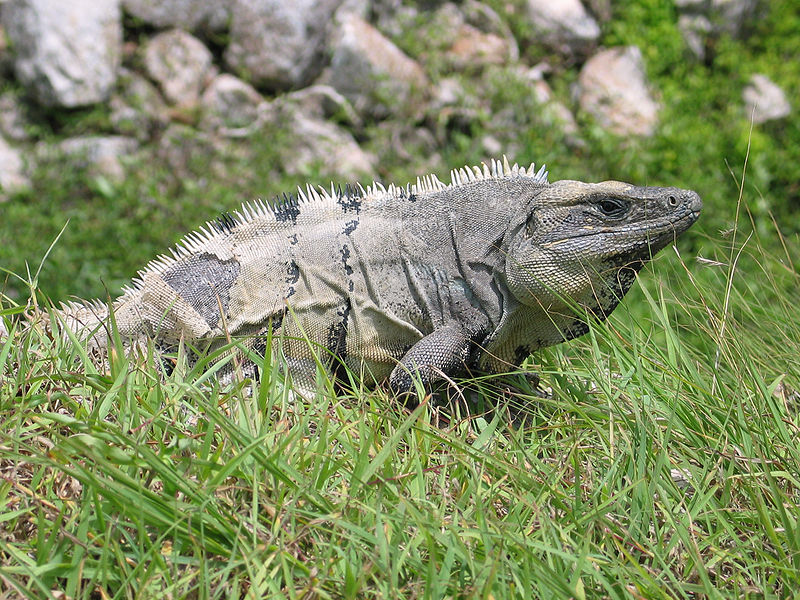With over 1,200 species, the skink family (Scincidae) is the lizard world’s largest, and in it we find some very unusual creatures. Yet one, the Crocodile Skink (Tribolonotus gracilis), stands out as being particularly unique even in this odd assemblage of reptiles. Originally thought to be a difficult animal to keep, we are now learning more and more about it, and captive reproduction is no longer a rarity. Let’s take a look at how this skink distinguishes itself.
Description
This species departs radically from the typical skink body plan. The head is enlarged, triangular in shape and capped with helmet-like scales, while four rows of thick, pointed scales line the back. Its color is dark brown to black, with a striking red or orange area about the eye. Crocodile Skinks average 6.5-7.8 inches in length.
Range
The Crocodile Skink is found only in Papua New Guinea and on the nearby Admiralty Islands. One additional species, the Spiny Skink, T. novaeguinea, (which also appears in the pet trade) inhabits New Guinea, and 6 other species within the genus are found on the Solomon Islands and in New Caledonia.
Habitat
Crocodile Skinks frequent damp, shaded mountain valleys near streams and, in contrast to most skinks (and lizards in general!), they prefer temperatures of 66-75 F.
Again unlike most skinks, they are largely nocturnal or crepuscular (active in early mornings and evenings). Although declining in some areas, recent observations indicate that piles of coconut husks on farms provide important habitat, and may help populations to increase.
Reproduction
Here again the rules are broken, with females laying only 1 egg at a time. Oddly, the left ovary and oviduct are somewhat regressed in development as compared to the right. The single egg developing on the left side is not laid until approximately 60 days after the right ovary’s egg has been laid. This is true for 7 of the 8 species of Tribolonotus…Schmidt’s Helmet Skink (T. schmidti) gives birth to a single live offspring. Well-fed female Crocodile Skinks may produce up to 6 eggs each year.
Female Crocodile Skinks guard their eggs during the 70 day incubation period. In captivity they cover the eggs with substrate when foraging and lunge at intruders. The hatchlings stay in close proximity to the female for approximately 2 weeks. Further study may reveal an even greater degree of social behavior, as males kept in the same enclosure are not hostile to the young or to the female.
Other Unusual Characteristics
Crocodile Skinks are unique among lizards in having glands under the abdominal scales, on the surface of the hands, and on the undersides of the feet. The function of these glands is not completely understood.
They also vocalize when disturbed – producing quite a loud “squawk” for such a small creature – and feign death when stressed. I can attest that both behaviors are very surprising to the uninitiated! Some vocalizations may be in response to egg disturbance – another lizard “first” (please see article below).
Further Reading
An interesting article detailing work carried out at the Dallas Zoo on Crocodile Skink vocalizations is posted here.
To read more about the largest lizard family, please see my article Skinks: an Overview.
A video of rarely seen display behavior is posted here.
I’ll cover the care of these most unusual lizards in a future article.
 That Reptile Blog – Reptile, Amphibian and Exotic Pet Care and Information
That Reptile Blog – Reptile, Amphibian and Exotic Pet Care and Information

 The Tropical Girdled Lizard (Cordylus tropidosternum) is the most readily available of the 30+ Cordylus species, and offers an excellent introduction to the group. It is sometimes sold as the “Armadillo Lizard”, confusing purchasers who had in mind another (and, at $1,200+ each, vastly more expensive!) species with the same common name, C. cataphractus. It also occasionally appears under the name “East African Spiny-tailed Lizard”.
The Tropical Girdled Lizard (Cordylus tropidosternum) is the most readily available of the 30+ Cordylus species, and offers an excellent introduction to the group. It is sometimes sold as the “Armadillo Lizard”, confusing purchasers who had in mind another (and, at $1,200+ each, vastly more expensive!) species with the same common name, C. cataphractus. It also occasionally appears under the name “East African Spiny-tailed Lizard”. (Iguana iguana) and the Chuckwalla (Sauromalus obesus). As we will see, this diverse group is also populated by a number of oddities as well – rare island dwellers and lizards that dive into icy ocean waters to munch on seaweed, for example.
(Iguana iguana) and the Chuckwalla (Sauromalus obesus). As we will see, this diverse group is also populated by a number of oddities as well – rare island dwellers and lizards that dive into icy ocean waters to munch on seaweed, for example. The Marine Iguana must surely be the strangest lizard in the family, if not the world. Indigenous to Ecuador’s Galapagos Islands, it feeds entirely on submerged marine algae (“seaweed”).
The Marine Iguana must surely be the strangest lizard in the family, if not the world. Indigenous to Ecuador’s Galapagos Islands, it feeds entirely on submerged marine algae (“seaweed”). Crocodile Monitors approach 9 feet in length – nearly as long as the famed Komodo Dragon, but less stoutly built. There are recurring but unverified reports of much longer individuals.
Crocodile Monitors approach 9 feet in length – nearly as long as the famed Komodo Dragon, but less stoutly built. There are recurring but unverified reports of much longer individuals.